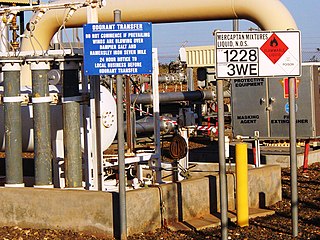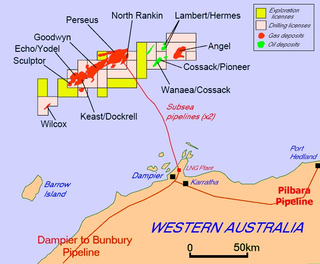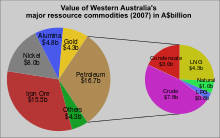
Santos Ltd. is an Australian oil and gas exploration and production company, with its headquarters in Adelaide, South Australia. It owns liquefied natural gas (LNG), pipeline gas, and oil assets. It is the biggest supplier of natural gas in Australia, with its plants in the Cooper Basin in South Australia and South West Queensland supplying the eastern states of Australia. Its operations also extend to the seas off Western Australia and Northern Territory.
Woodside Energy Group Ltd is an Australian petroleum exploration and production company. Woodside is the operator of oil and gas production in Australia and also Australia's largest independent dedicated oil and gas company. It is a public company listed on the Australian Securities Exchange and has its headquarters in Perth, Western Australia. In the 2020 Forbes Global 2000, Woodside was ranked as the 1328th-largest public company in the world.

China Petroleum and Chemical Corporation, or Sinopec, is a Chinese oil and gas enterprise based in Beijing. It is listed in Hong Kong and also trades in Shanghai.

Sonatrach is the national state-owned oil company of Algeria. Founded in 1963, it is known today to be the largest company in Africa with 154 subsidiaries, and often referred as the first African oil "major". In 2021, Sonatrach was the seventh largest gas company in the world.

Petroleum production in Canada is a major industry which is important to the overall economy of North America. Canada has the third largest oil reserves in the world and is the world's fourth largest oil producer and fourth largest oil exporter. In 2019 it produced an average of 750,000 cubic metres per day (4.7 Mbbl/d) of crude oil and equivalent. Of that amount, 64% was upgraded from unconventional oil sands, and the remainder light crude oil, heavy crude oil and natural-gas condensate. Most of the Canadian petroleum production is exported, approximately 600,000 cubic metres per day (3.8 Mbbl/d) in 2019, with 98% of the exports going to the United States. Canada is by far the largest single source of oil imports to the United States, providing 43% of US crude oil imports in 2015.

Shell Australia is the Australian subsidiary of Shell. Shell has operated in Australia since 1901, initially delivering bulk fuel into Australia, then establishing storage and distribution terminals, oil refineries, and a network of service stations. It extended its Australian activities to oil exploration, petrochemicals and coal mining, and became a leading partner in Australia's largest resource development project, the North West Shelf Venture.

The Petroleum or oil industry in Russia is one of the largest in the world. Russia has the largest reserves and was the largest exporter of natural gas. It has the sixth largest oil reserves, and is one of the largest producers of oil. It is the fourth largest energy user.

The Dampier to Bunbury Natural Gas Pipeline (DBNGP) is the longest natural gas pipeline in Australia. It is 660mm in diameter, which also makes it one of Australia's largest in terms of transmission capacity. At the time of its commissioning in 1984, it was one of the longest gas pipelines in the world.

QatarEnergy, formerly Qatar Petroleum (QP), is a state owned petroleum company of Qatar. The company operates all oil and gas activities in Qatar, including exploration, production, refining, transport, and storage. The President & CEO is Saad Sherida al-Kaabi, Minister of State for Energy Affairs. The company's operations are directly linked with state planning agencies, regulatory authorities, and policy making bodies. Together, revenues from oil and natural gas amount to 60% of the country's GDP. As of 2018 it was the third largest oil company in the world by oil and gas reserves. In 2022, the company had total revenues of US$52bn, a net income of US42.4bn, and total assets of US$162bn. In 2021, QatarEnergy was the fifth largest gas company in the world.
Onshore, when used in relation to hydrocarbons, refers to an oil, natural gas or condensate field that is under the land or to activities or operations carried out in relation to such a field.
The National Oil Corporation is the national oil company of Libya. It dominates Libya's oil industry, along with a number of smaller subsidiaries, which combined account for around 70% the country's oil output. Of NOC's subsidiaries, the largest oil producer is the Waha Oil Company (WOC), followed by the Arabian Gulf Oil Company (Agoco), Zueitina Oil Company (ZOC), and Sirte Oil Company (SOC).

The Energy in Russia is an area of the national economy, science, and technology of the Russian Federation, encompassing energy resources, production, transmission, transformation, accumulation, distribution, and consumption of various types of energy.

The North West Shelf is a continental shelf region of Western Australia. It includes an extensive oil and gas region off the North West Australia coast in the Pilbara region.

The North West Shelf Venture, situated in the north-west of Western Australia, is Australia's largest resource development project. It involves the extraction of petroleum at offshore production platforms, onshore processing and export of liquefied natural gas, and production of natural gas for industrial, commercial and domestic use within the state.
West Australian Petroleum Pty Ltd (WAPET) was a pioneer oil and gas exploration and processing company in Western Australia.

The Western Australian gas crisis was a major disruption to natural gas supply in Western Australia, caused by the rupture of a corroded pipeline and subsequent explosion at a processing plant on Varanus Island, off the state's north west coast on 3 June 2008. The plant, operated by Apache Energy, which normally supplied a third of the state's gas, was shut down for almost two months while a detailed engineering investigation and major repairs were carried out. Gas supply from the plant partially resumed in late August. By mid-October, gas production was running at two-thirds of normal capacity, with 85% of full output restored by December 2008.

Petroleum has been a major industry in the United States since the 1859 Pennsylvania oil rush around Titusville, Pennsylvania. Commonly characterized as "Big Oil", the industry includes exploration, production, refining, transportation, and marketing of oil and natural gas products. The leading crude oil-producing areas in the United States in 2023 were Texas, followed by the offshore federal zone of the Gulf of Mexico, North Dakota and New Mexico.
Energy security of the People's Republic of China concerns the need for the People's Republic of China to guarantee itself and its industries long- term access to sufficient energy and raw materials. China has been endeavoring to sign international agreements and secure such supplies; its energy security involves the internal and foreign energy policy of China. Currently, China's energy portfolio consists mainly of domestic coal, oil and gas from domestic and foreign sources, and small quantities of uranium. China has also created a strategic petroleum reserve, to secure emergency supplies of oil for temporary price and supply disruptions. Chinese policy focuses on diversification to reduce oil imports, which used to rely almost exclusively on producers in the Middle East.

Iran is an energy superpower and the petroleum industry in Iran plays an important part in it. In 2004, Iran produced 5.1 percent of the world's total crude oil, which generated revenues of US$25 billion to US$30 billion and was the country's primary source of foreign currency. At 2006 levels of production, oil proceeds represented about 18.7% of gross domestic product (GDP). However, the importance of the hydrocarbon sector to Iran's economy has been far greater. The oil and gas industry has been the engine of economic growth, directly affecting public development projects, the government's annual budget, and most foreign exchange sources.
Australia is a major petroleum producer and importer, with a number of petroleum companies involved in upstream and downstream operations. Western Australia is the largest contributor to Australia's production of most petroleum products.





















